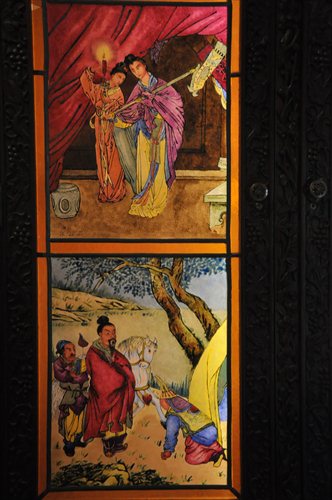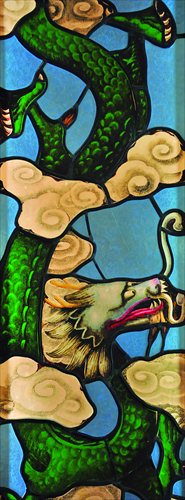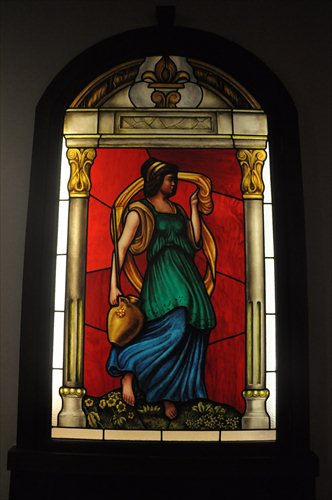Colored memories
Stained-glass windows are an almost forgotten part of city’s history
Stained-glass windows are one of the defining features of churches and cathedrals of the West. These beautiful combinations of color, light and storytelling originated in medieval Europe, and were essential decoration for Gothic churches during the 13th and 14th centuries.
The craft didn't make it to China until around a century ago, when Westerners brought it to Shanghai. According to local historical documents, the T'ou-Sè-Wè Workshop in Xuhui district was the first stained glassmaker in China, beginning production in 1913.
Stained-glass windows soon became common in churches, banks and financial companies across the city. Around 20 percent of these were imported, but the rest were made at the T'ou-Sè-Wè Workshop.

Stained glass at the T'ou-Sè-Wè Museum Photos: Huang Lanlan/GT

Stained glass at the T'ou-Sè-Wè Museum Photos: Huang Lanlan/GT

Stained glass at the T'ou-Sè-Wè Museum Photos: Huang Lanlan/GT

Stained glass at the T'ou-Sè-Wè Museum Photos: Huang Lanlan/GT
Orphan workers
The T'ou-Sè-Wè Workshop was founded by the T'ou-Sè-Wè Orphanage (L'Orphelinat de T'ou-sè-wè) in 1864, which itself had been founded by Western missionaries. The workshop was originally built to make religious supplies for churches in Asia, and later became a place at which young orphans could learn new skills.
Homeless boys aged 11 and over were taught skills that included drawing, carving, printing and stained glassmaking.
One of the orphans was Chen Fuxiao. Born in 1928, he learned to make stained glass at the workshop between 1941 and 1960. In a recent interview with the current T'ou-Sè-Wè Museum staff, Chen described the process.
Coloring the glass was achieved by adding oxides to heated glass. "For example, adding cupric oxide we can get green glass, and adding cobaltous oxide we get blue glass," Chen said. After that, small pieces of colored glass were sealed together, and are later fired at temperatures of between 600 and 800 C for 12 hours. "Then, after cooling the glass for six or seven hours, we could put it into a wooden frame," he said.
The T'ou-Sè-Wè Workshop's creations, with their gorgeous colors, delicate designs, high-quality craftsmanship and unique combinations of Western and traditional Chinese art, were soon in great demand domestically and overseas.
Fragile legacy
Unfortunately, very few of the stained-glass windows made at T'ou-Sè-Wè Workshop remain in Shanghai today, as many were destroyed during the wars and turbulence of the past century.
According to Liu Ying, vice director of the T'ou-Sè-Wè Museum, people can still enjoy the beauty of T'ou-Sè-Wè stained glass at three places: the T'ou-Sè-Wè Museum, a building on Guangdong Road, and a kindergarten on Yuqing Road.
Opened to the public in 2010, the T'ou-Sè-Wè Museum (55 Puhuitang Road, 5424-9688) is located on the former site of the T'ou-Sè-Wè Orphanage. One of its most worth-visiting exhibits is an exquisite stained-glass cabinet, which was showcased at the Panama-Pacific International Exposition in San Francisco in 1915.
The 2.1-meter-tall and 1.5-meter-wide cabinet's two doors have six pieces of stained glass, which depict six classical Chinese folk stories (pictured middle). Between the two doors, the cabinet is inlaid with another piece of stained glass, vividly portraying a green dragon flying through the clouds (pictured far left).
"Making the cabinet took at least 10 people three years," Xu Wendie, a guide at the museum, told the Global Times.
After being showcased at the international exposition, the cabinet was bought by an American professor and kept in the US.
It didn't return to China until the T'ou-Sè-Wè Museum bought it in December 2013.
Glass around town
Standing in front of the historical European-style architecture on 93 Guangdong Road, your eye is drawn to the huge stained-glass windows of the first floor. Their images depict Western religious figures such as Jesus Christ and the Madonna, and are still in good condition.
The kindergarten at 190 Yuqing Road is a former residence of Chen Yi (1901-1972, Shanghai's first mayor. Inside the main building of the kindergarten, visitors can see three tall stained-glass windows on the wall when they go upstairs.
Unlike most other religious-style windows, these three examples show people in a romantic fantasy undersea world with blue water, colorful seaweed and fish.